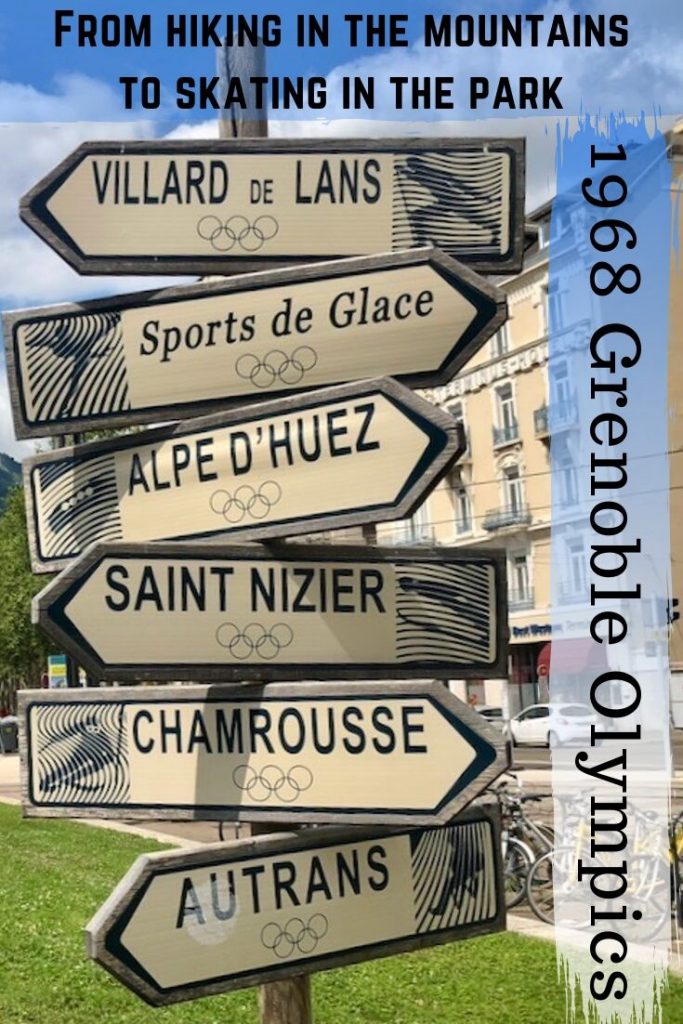Grenoble Olympics half a century later: from hiking in the mountains to skating in the park
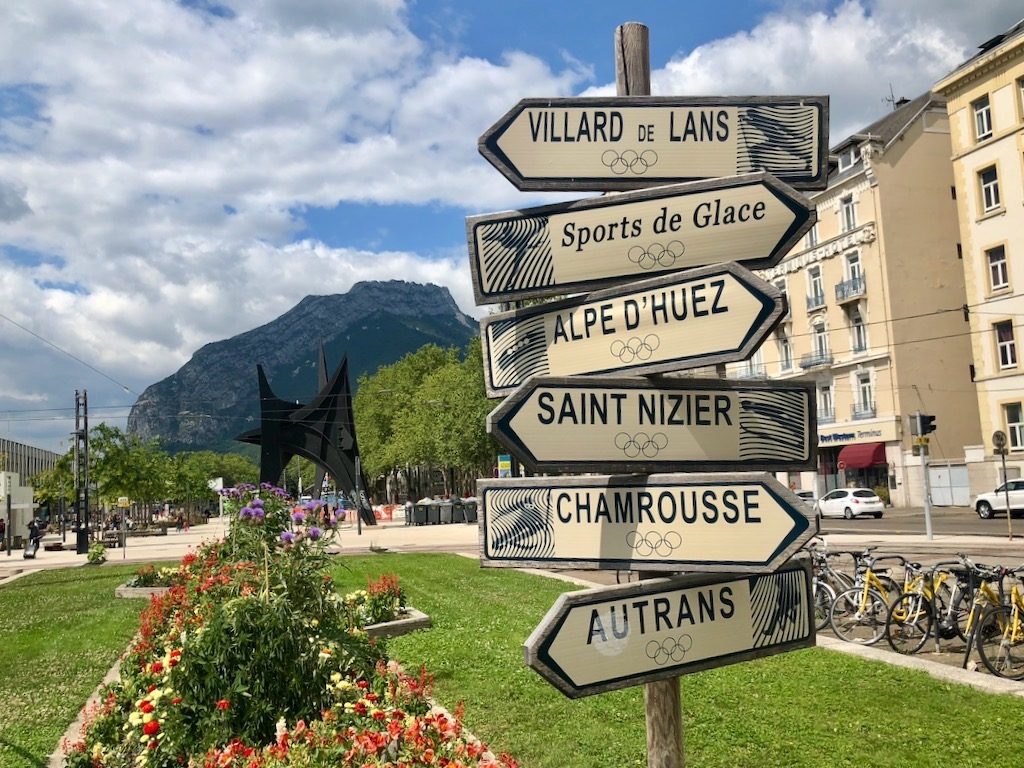
Grenoble 1968 Olympic Winter Games waded into this story by accident: a hiking trail happened to pass through an abandoned piece of sporting history. Once mentioned, though, they refused to go away. In hindsight, a hunt for the remaining Olympic sites around Grenoble is worthy of being one of the top activities there.
What to do in Grenoble during summer
Living in Grenoble is unfathomable without sporting activities. Sure, skiing et al. rule in winter. Hiking and bicycling are for summer.
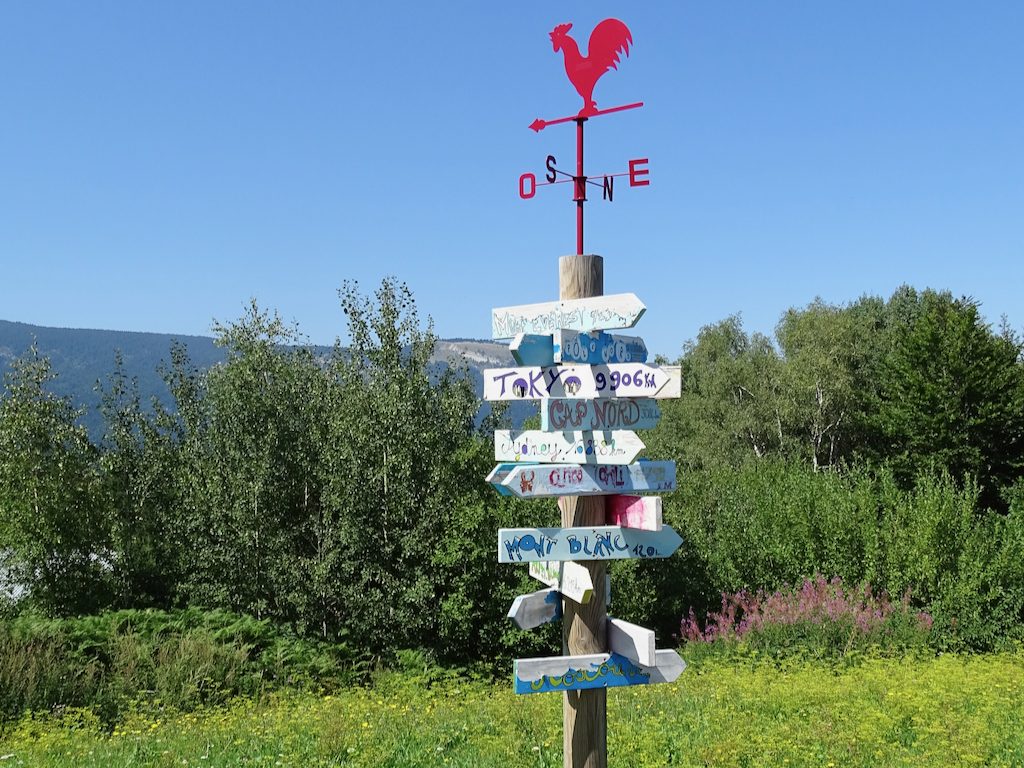
It was during one of our hiking excursions when we discovered curious ruins.
If you follow our adventures, you might remember that I am crazy about abandoned places. Remember Foinikas Story: An Abandoned Phoenix or A Forgotten Palm Tree? It was so much fun! This time, the site looked way more modern.
But let’s start from the beginning.
Le Moucherotte
Looking for a picturesque place to hike, Le Moucherotte caught our attention.
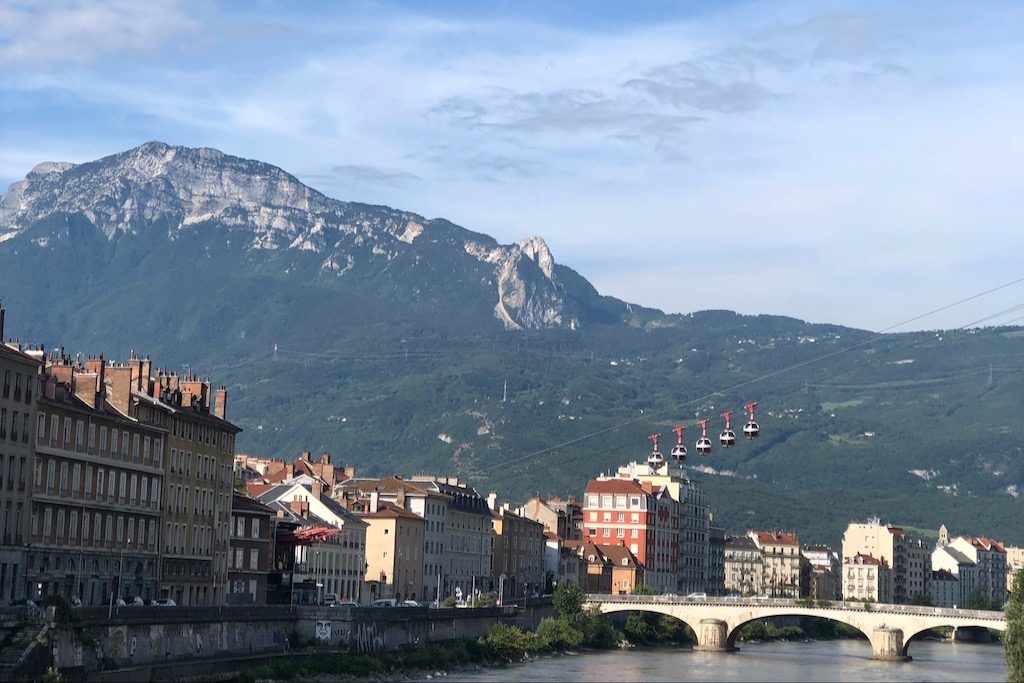
At 1901 meters, Le Moucherotte is the easternmost peak of the Vercors Massif. It is the northern point of the long ridge that runs along the eastern edge of the Vercors plateau and overlooks Grenoble.
The maps showed some promising tracks leading to the top. But, perhaps, it was a picture of three rocks, known as the Three Maidens, that sealed the deal. According to local history, they were used in the resistance during the second world war by the maquis of Saint-Nizier-of-Moucherotte.
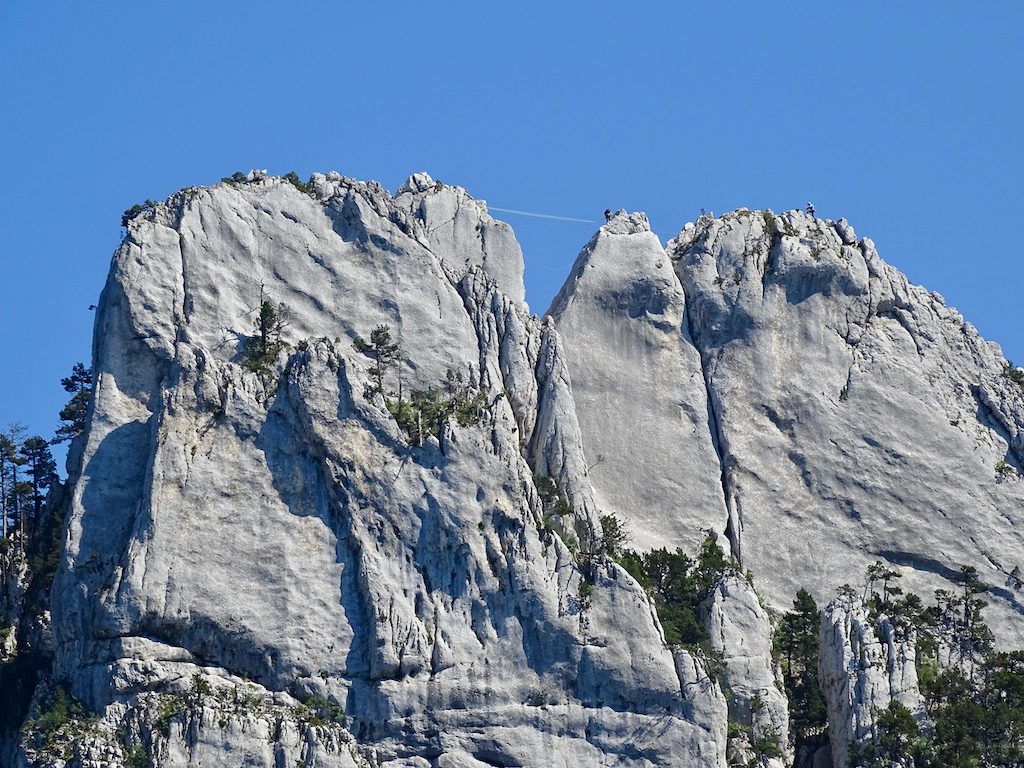
Close proximity to Grenoble makes Le Moucherotte even more attractive. Apparently, this thought occurred to wealthy Grenoblians too. From the 50s to the 70s of the last century, Saint-Nizier-du-Moucherotte was a popular place to spend a weekend for the jet-set of the time.
Consequently, a local entrepreneur built a stately hotel appropriately named l’Ermitage, at the top of the summit. A cable car was transferring visitors between the village and the hotel. Sadly, this bucolic set up didn’t last.
Soon, it was abandoned and left in ruins. With the turn of the century, both the hotel and the gondola station were demolished. Today, there is almost no trace of neither, and nature took over.
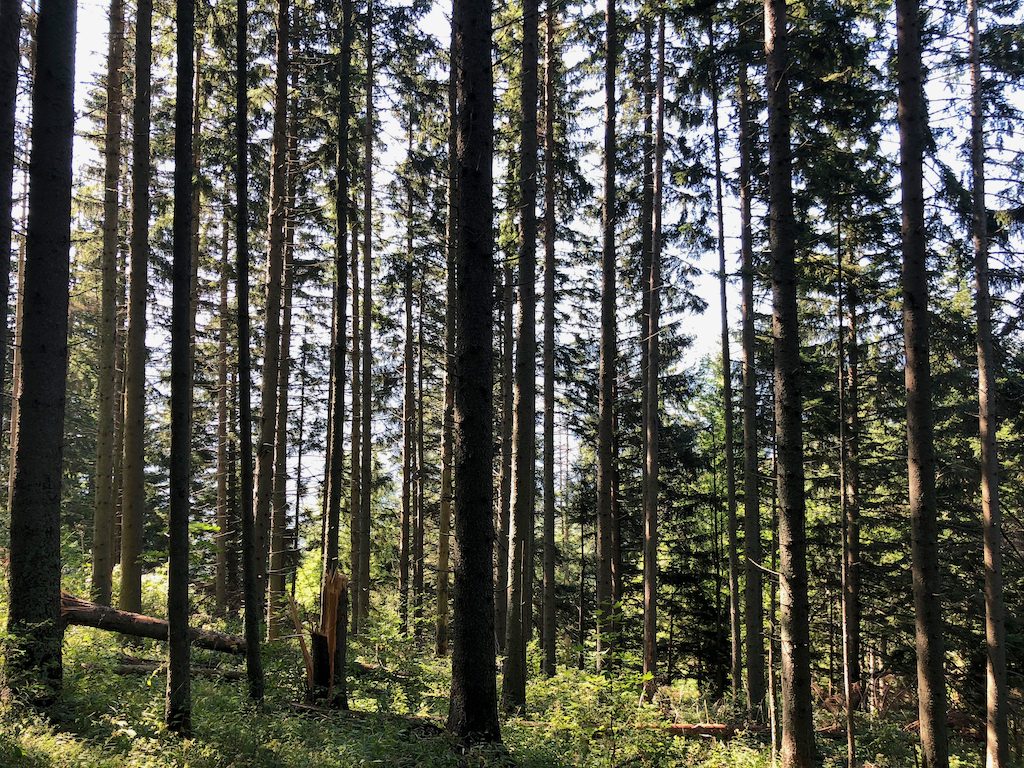
I like this “return to nature” approach. Instead of merely abandoning structures (seemingly, the most common way to deal with empty buildings) or repurposing them, the locals remove their invasions leaving mountains alone.
Does it contradict my affinity for the abandoned places? Well… You see, I am willing to make an exception here or there. The Alps are too glorious in their raw beauty to be subjected to manmade intrusions.
An unexpected discovery
On a sunny afternoon, a forest stood still basking in a late-summer heat. Seemingly, trees were wiser than humans and decided to sleep through the hottest time of the day.
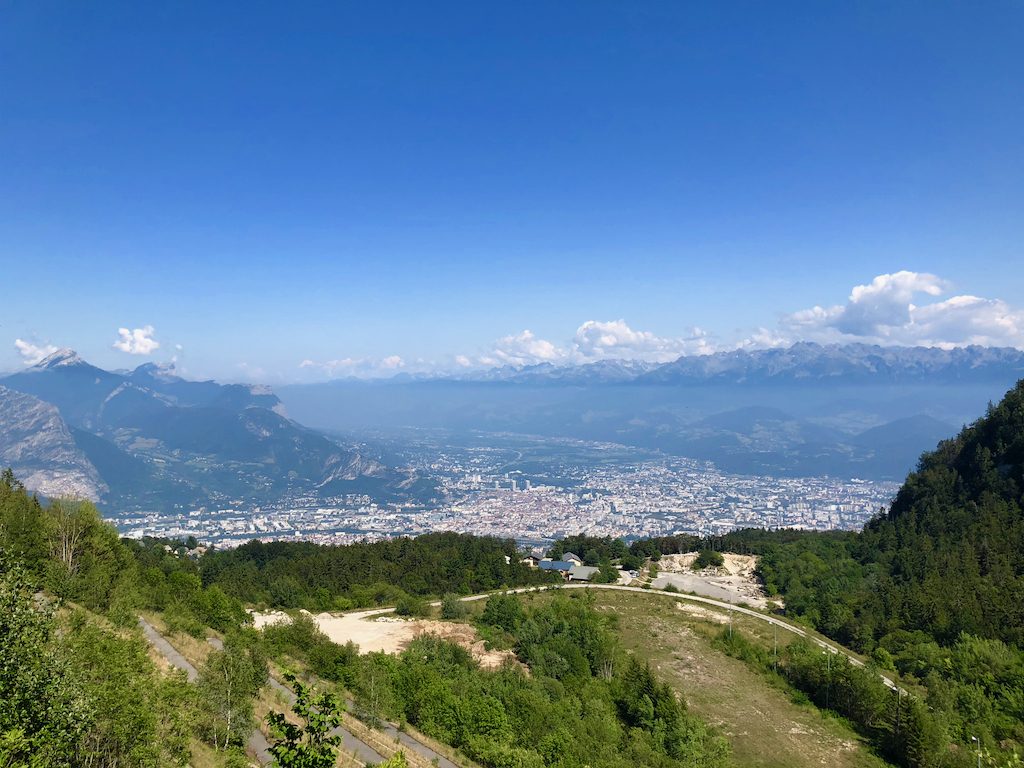
Grenoble was just a few minutes away. Yet, it looked like it could be on a different planet. Pastoral views of alpine fields and a few villages were all one can see between trees.
Getting closer to the edge of a forest, the only sound was the constant buzz of bees tirelessly zooming between a sea of flowers. Even birds retired for a midday break.
Mercifully, a winding path was snaking under towering pines, thus keeping hikers in a shadow.
This luxury, though, didn’t last. Tall, stately trees gave way to leafy underlings and, finally, an opening.
It took a few moments to adjust to bright afternoon sun to look around.
An odd structure was standing in the middle of a clearing. Clearly, it was abandoned for a while by now. Enough time had passed for greenery and even trees to grew into it. Yet, a strange shape was still visible.
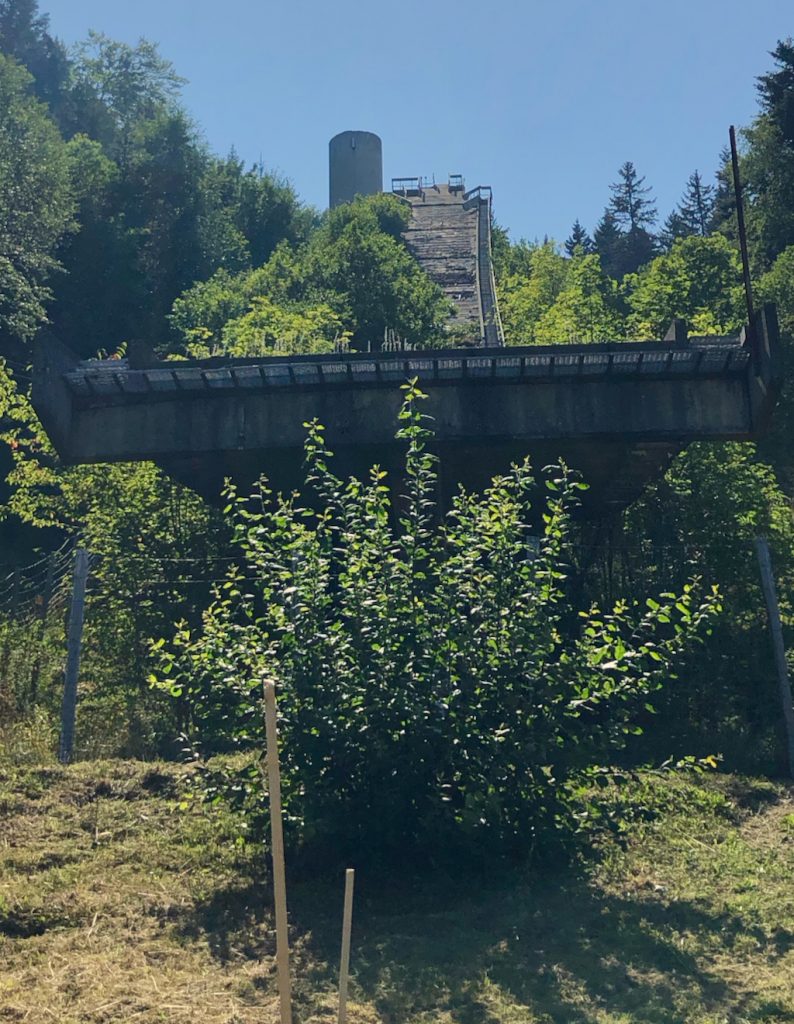
Why a tall concrete manmade object would be sitting in the middle of nowhere?
Tremplin de saut olympique
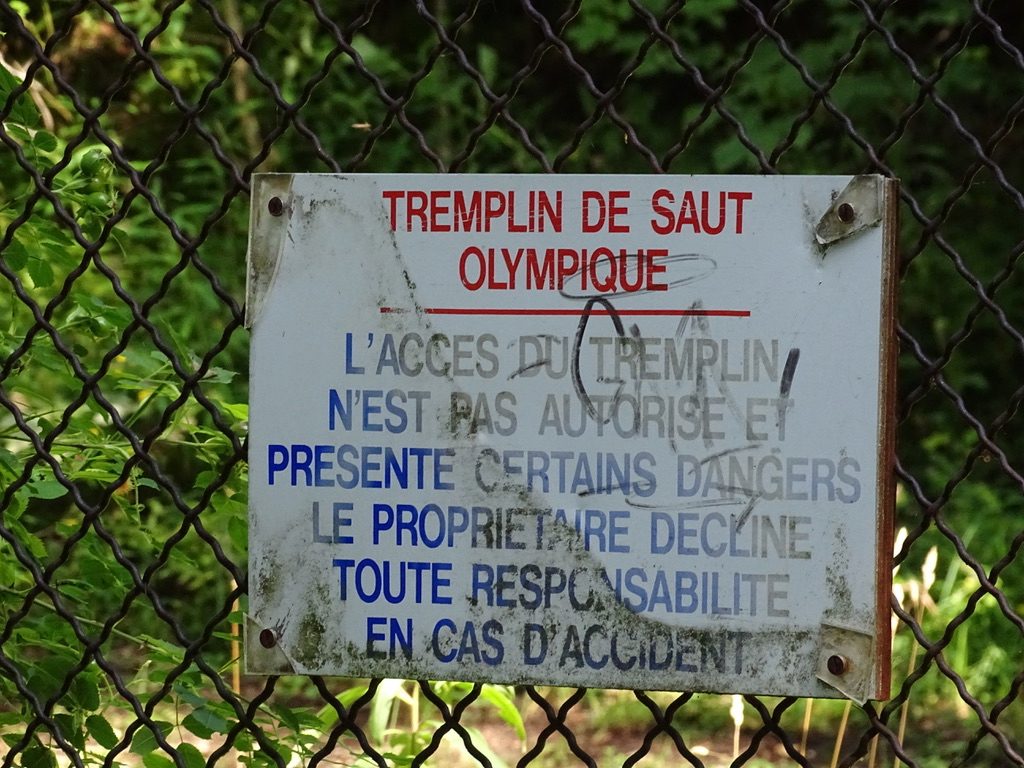
Suddenly, the sign put everything in place. We were standing in front of the abandoned Ski Jump Hill of the Grenoble Olympic Games.
More than fifty years had passed since then.
Emerging from the forest, we found ourselves in the middle of the complex. Although in disrepair and drowning in greenery, there are a few standalone structures still standing around.
The concrete spectators’ seats form an amphitheater overlooking what used to be a landing area at the bottom of the hill.
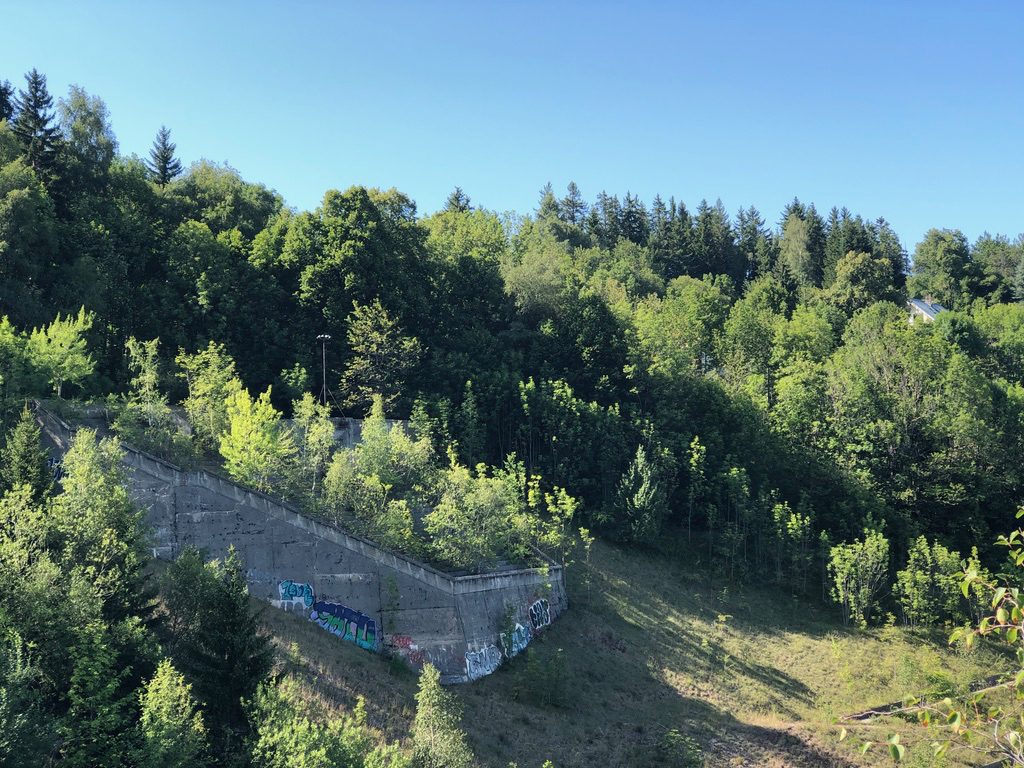
Evidently, the administrative building that housed sports officials and judges was accessible via the tunnel.
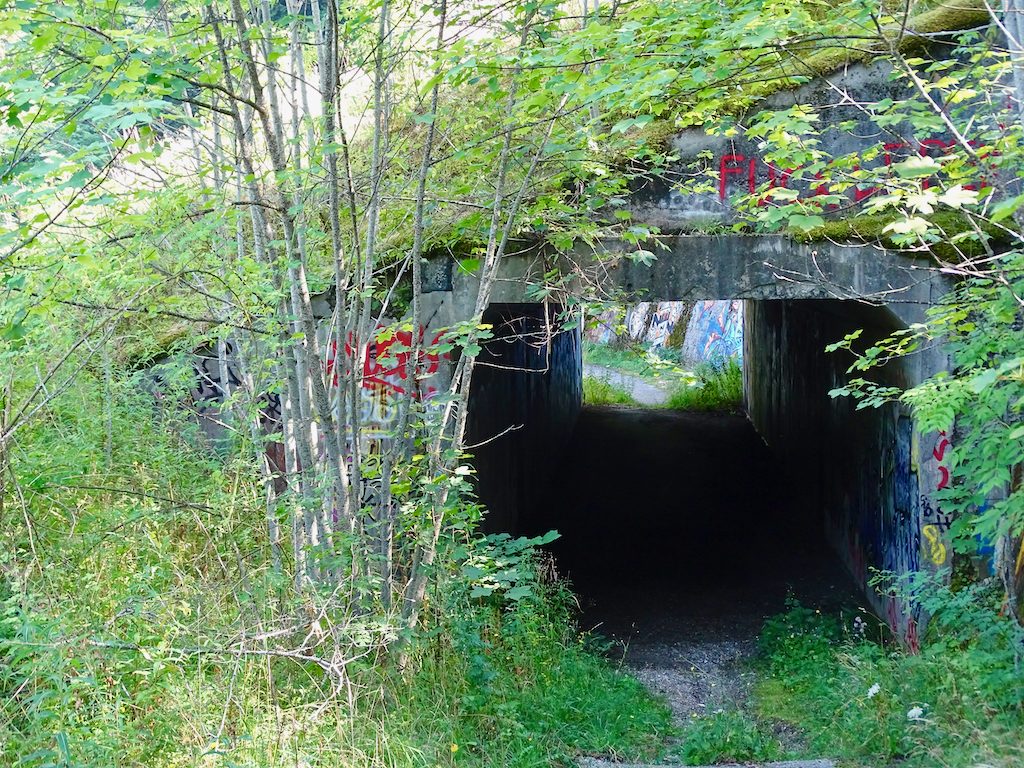
Unless you are a monkey, getting to its bowels is not an option these days. However, as originally intended, the roof forms a perfect observation deck that is still accessible and in good shape.
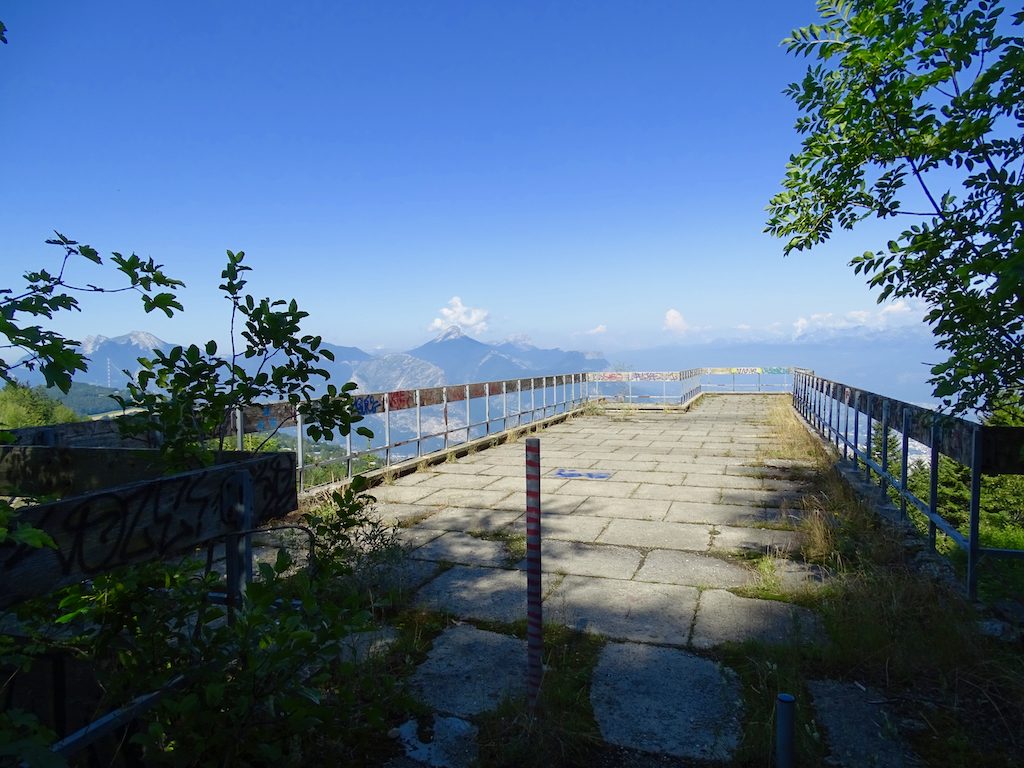
The panoramic views from there are worth a trip. The Three Maidens mentioned above were soo close that we could follow the progress of rock climbers up there with a naked eye.
Street Art on the Hill
Naturally, street artists found this place way before us. There are a few memorable murals that look fairly recent.
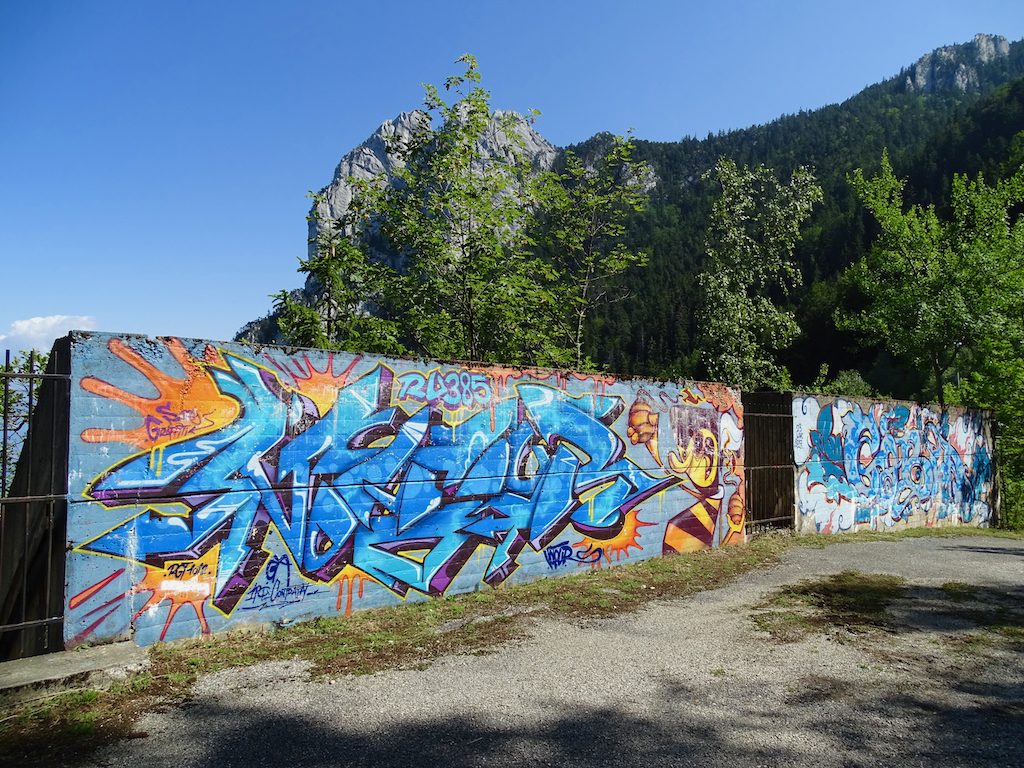
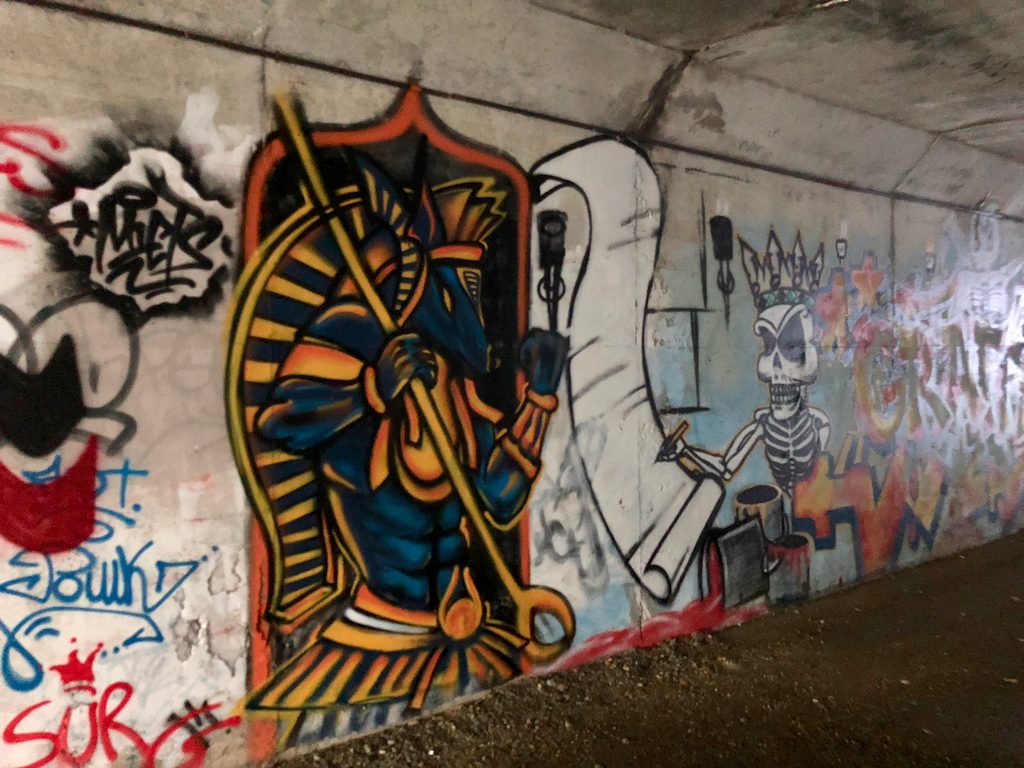
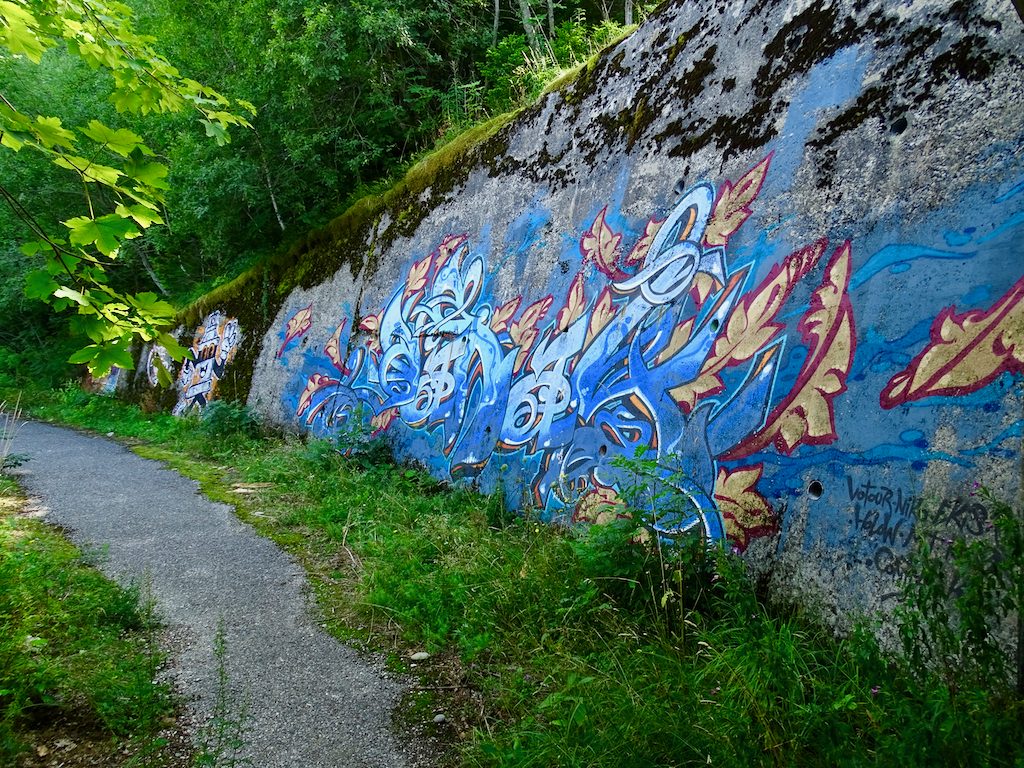
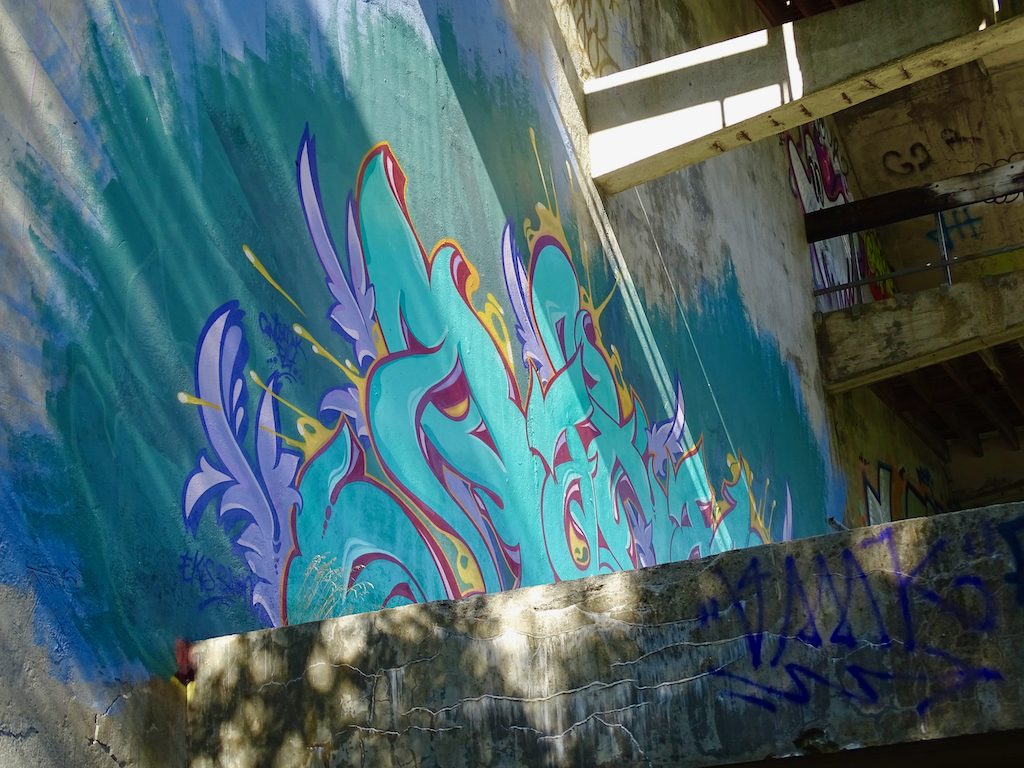
Votour and Contratak left their mark there. As for the others…
The Tower
Along the fence, steps hiding in the grass are going all the way up to the tower. The climb is steep and could be tricky for a kid or an older person.
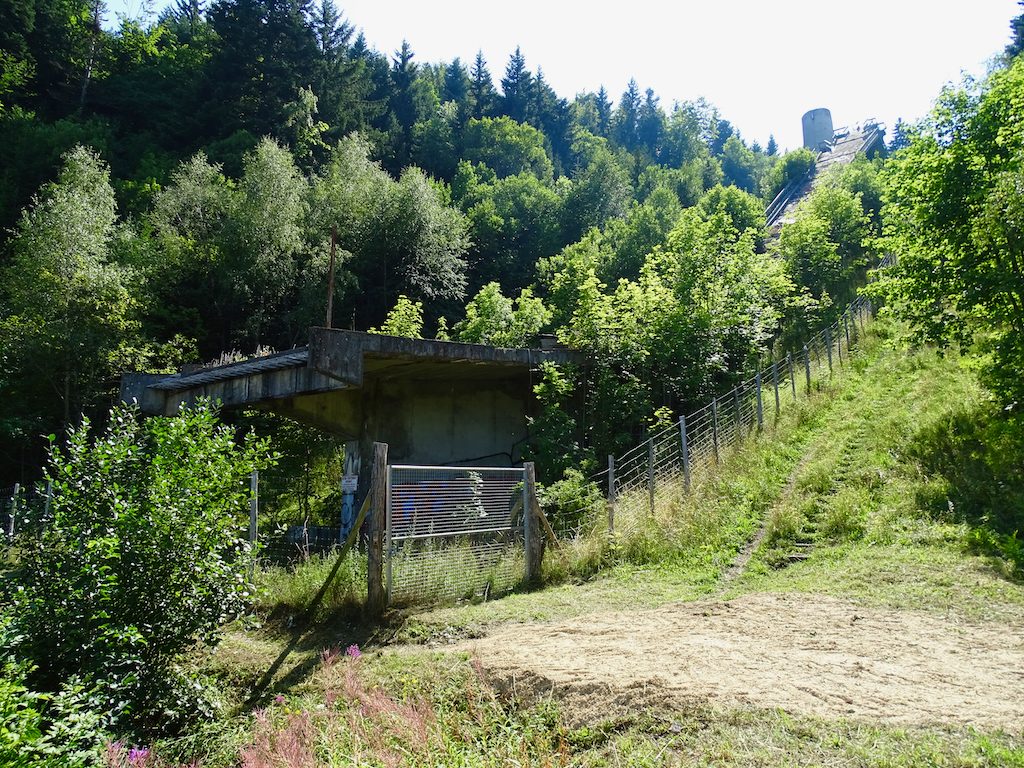
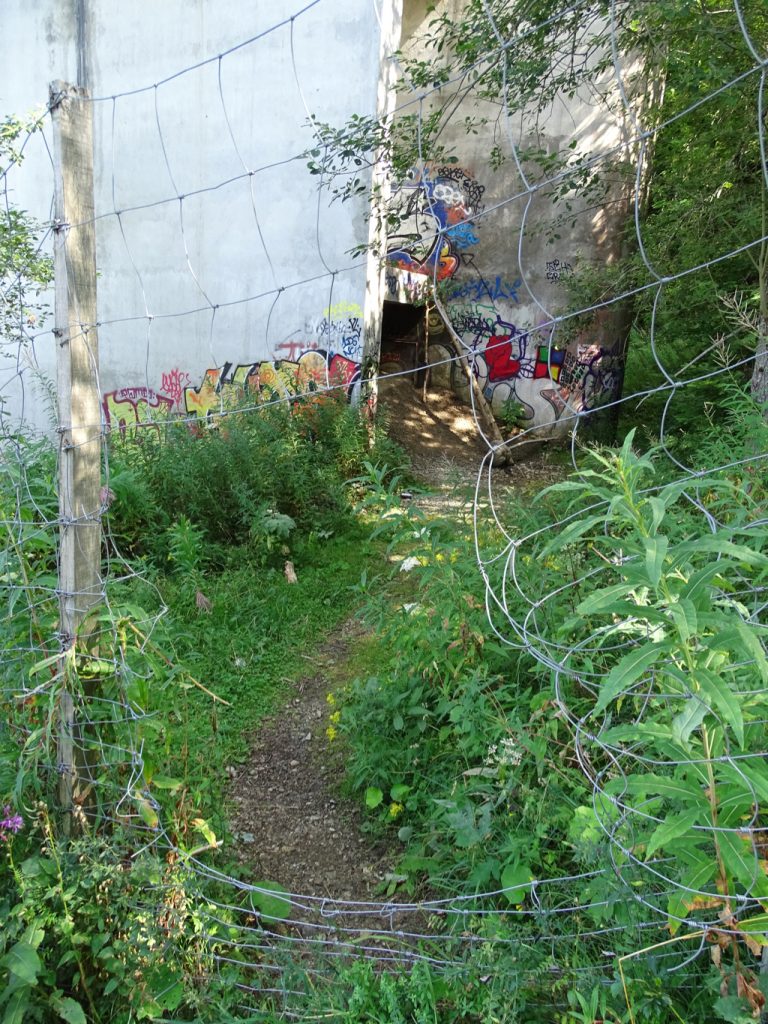
The tower, though, worth the sweaty efforts.
If you like ruins, you would appreciate this urban-like decay leisurely settled in a forest.
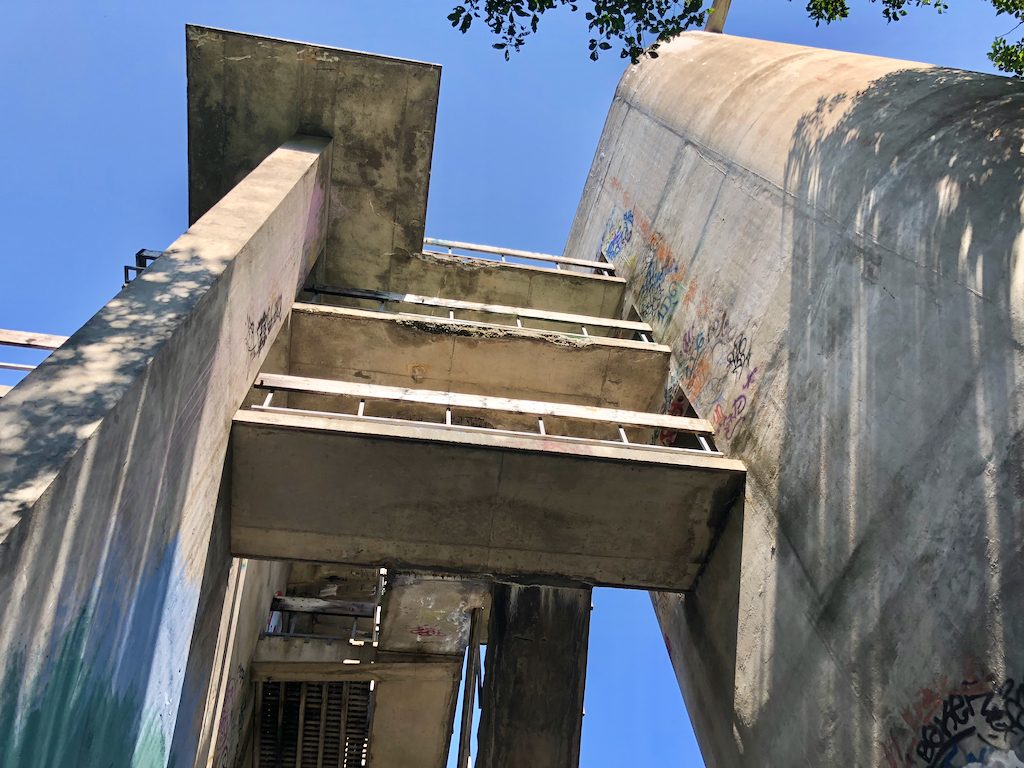
If you are an aspiring photographer, you would be caught between breathtaking views and intricate play of sun and shades.
You can even climb up to the higher levels of the tower courtesy of some adventurous souls who left behind a pine trunk they craftily used as a springboard. Of course, a sane person shouldn’t be trying this trick.
We spent a better part of an afternoon exploring all nooks and crannies of the Ski Jump Hill. Luckily, summer days are long, albeit a tad too hot. Hence, if you venture there, make sure you have plenty of water.
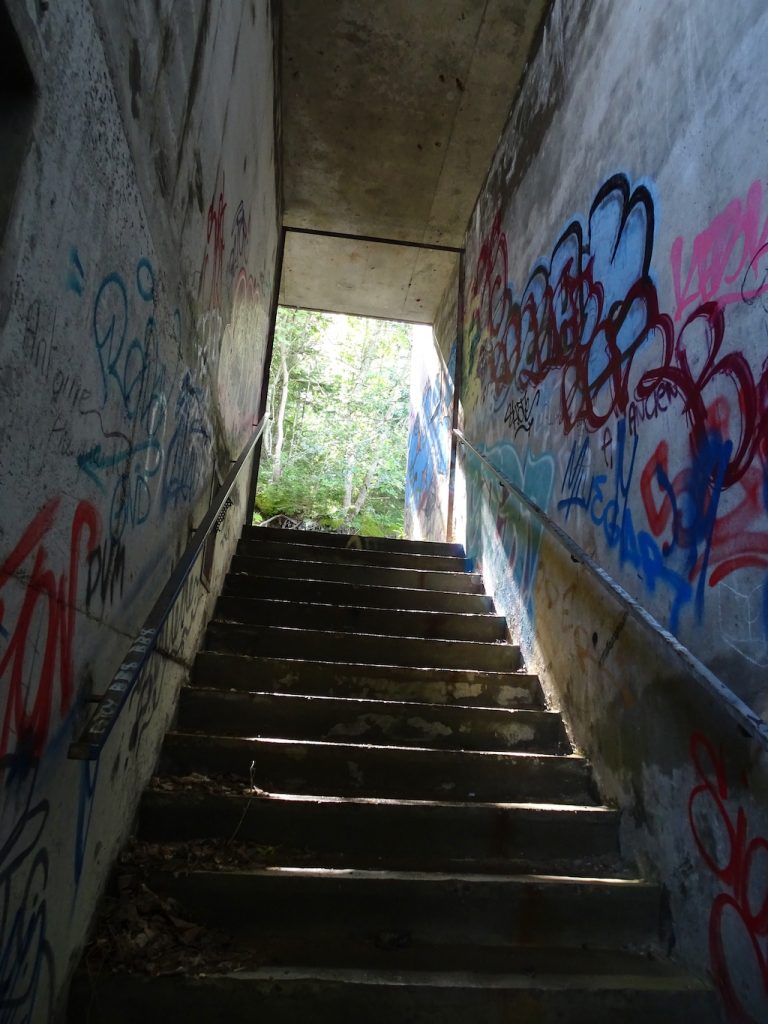
Inevitably, our discovery brought a question about what happened there and why the hill was abandoned?
The sad story of Tremplin du Dauphiné
Tremplin du Dauphiné was the 90m (aka Big) Ski Jump Hill. The interesting fact about this venue is that the location was chosen because of fantastic views of Grenoble, and close proximity (just 17km) to the city. It was built in 1967.
After the Olympics, it continued to host ski jumping events for almost a quarter of the century. Finally, the site was abandoned in the early 90s to avoid competition with the Courchevel venue built for the 1992 Albertville Olympics.
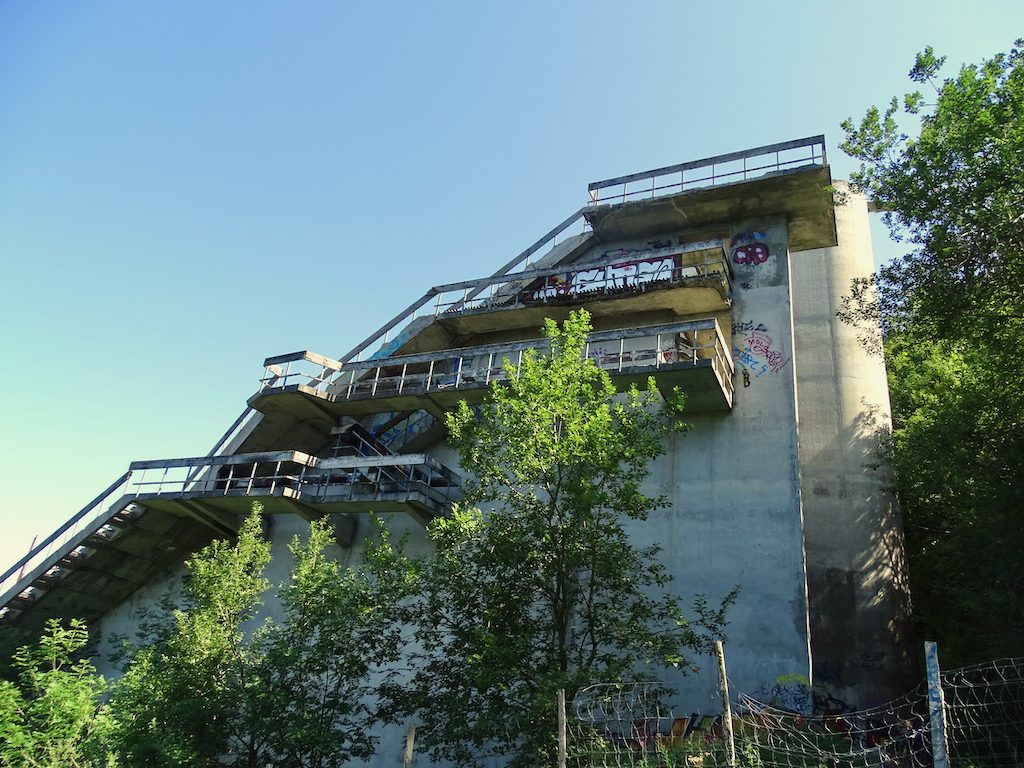
Thus, Tremplin du Dauphiné, which is no longer up to standard for major ski events, is still standing in ruins since its demolition would be too costly for the municipality.
All in all, Tremplin du Dauphiné is a curious relic from a bygone era, but it also sparked my interest in finding more about the Winter Olympic Games in Grenoble.
Grenoble Olympics Trivia
- The X Olympic Winter Games (the official name of the event) were held in Grenoble in February 1968. The Games transformed the city into a regional capital and helped with further development of winter sports in France.
- The opening ceremony took place on February 6, 1968 in a specially designed temporary stadium. It was dismantled almost immediately after the Games.
- 1,158 athletes from 37 countries participated in the Games.
- For the first time, the East Germany and West Germany competed as separate teams (they continued to do so until 1988.)
- Grenoble Olympics were the first games to be broadcast in color.
- An Olympic mascot appeared (unofficially) for the first time.
Grenoble 1968 Memory Lane
Frankly, I think the Olympic Games lost their luster decades ago. They became too expensive, too corrupt, too… boring. Yet, being at the site of the 1968 Winter Olympic Games felt special. What happened to other venues? Any other landmarks left around the city?
Becoming a 1968 Winter Olympics sleuth was kind of a natural progression from an accidental explorer of the Ski Jump Hill in Saint-Nizier-du-Moucherotte.
It was a fun detective adventure. However, finding information about an event that took place a mere half-a-century ago happened to be surprisingly challenging. At first sight, it seemed like there was plenty of resources. Looking closer, too often they just replicated the same narrative without even going into details.
Olympic venues within city limits
The Olympic Stadium (aka Opening Stadium)
What a bummer, the Olympic Stadium, where the opening ceremony took place is no longer exist. It was a temporary horseshoe-shaped structure built to welcome 60,000 people for the Opening Ceremony. The stadium was dismantled in March 1968, just a few days after the close of the Games. Today, city sprawl swallowed the area erasing any reminders of the place.
The Olympic Cauldron (Flamme Olympique des J.O. 1968)
An Olympic cauldron has to be one of the most notorious Olympic symbols. After all, along with the Olympic flame, it is present in different shapes and forms at every Game. Yet, on my first encounter, I walked by failing to recognize it.
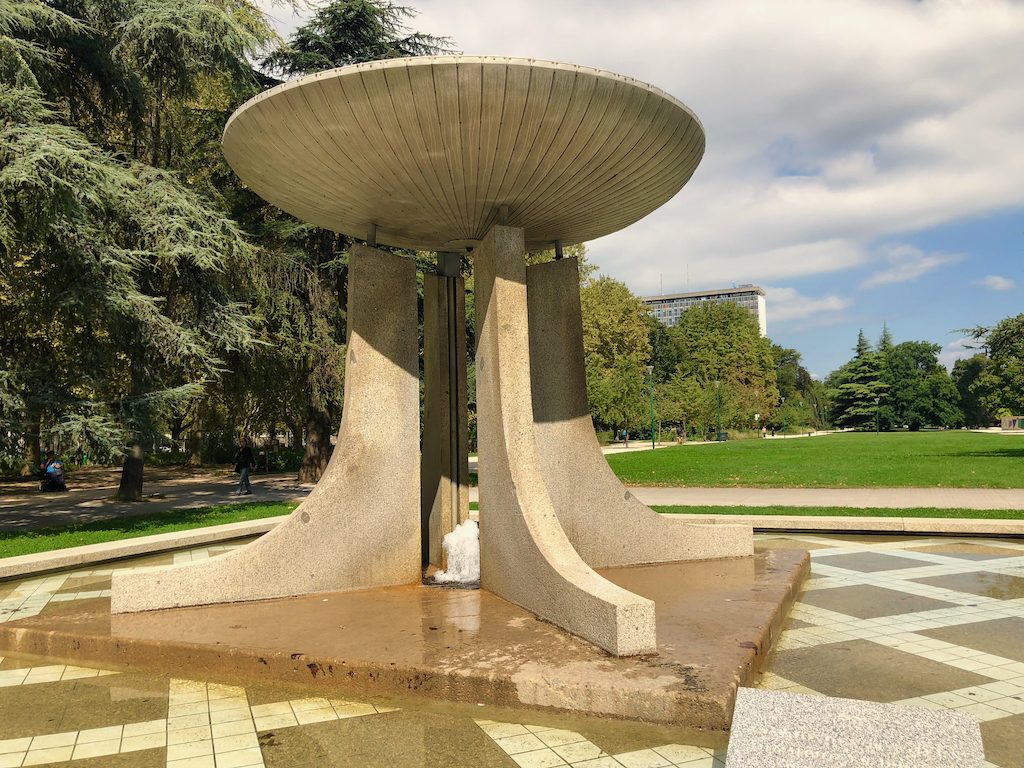
Actually, there was a good reason for my mistake. You see, originally the cauldron was located at the Olympic Stadium as everybody would expect. However, after the stadium was disassembled shortly after the Games, the cauldron was moved to Paris. Years later, it came back to Grenoble and found its permanent place in Paul Mistral Park in the form of a… fountain.
Kind of creative transformation from fire to water, but a bit far fetched for an unsuspecting visitor.
The Olympic Flagpole
Although the Olympic Stadium is long gone, the mast from where the Olympic flag was flying still stands. According to unconfirmed local sources, it stands in the middle of a busy intersection.
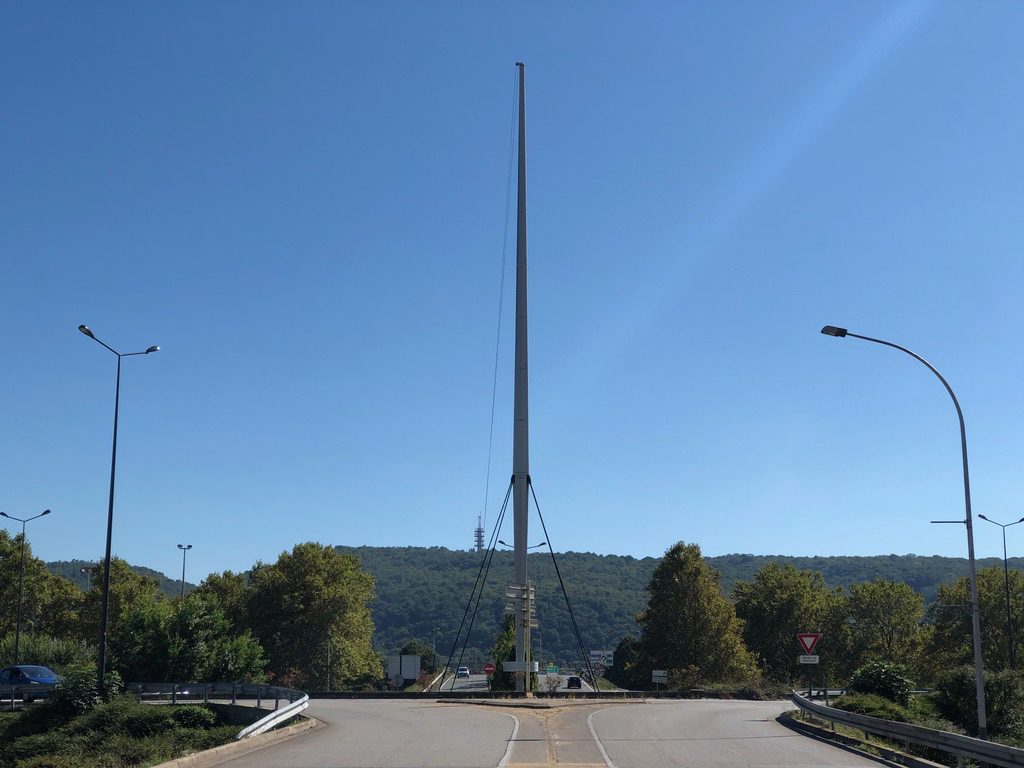
Presently located at the axis of the ALPEXPO roundabout, the 30m high Olympic mast carried the 5-ring (6mx9m) flag for the duration of the Games.
The Olympic Village
The village still exists. If you happened to walk through it, it looks like just another aging neighborhood.
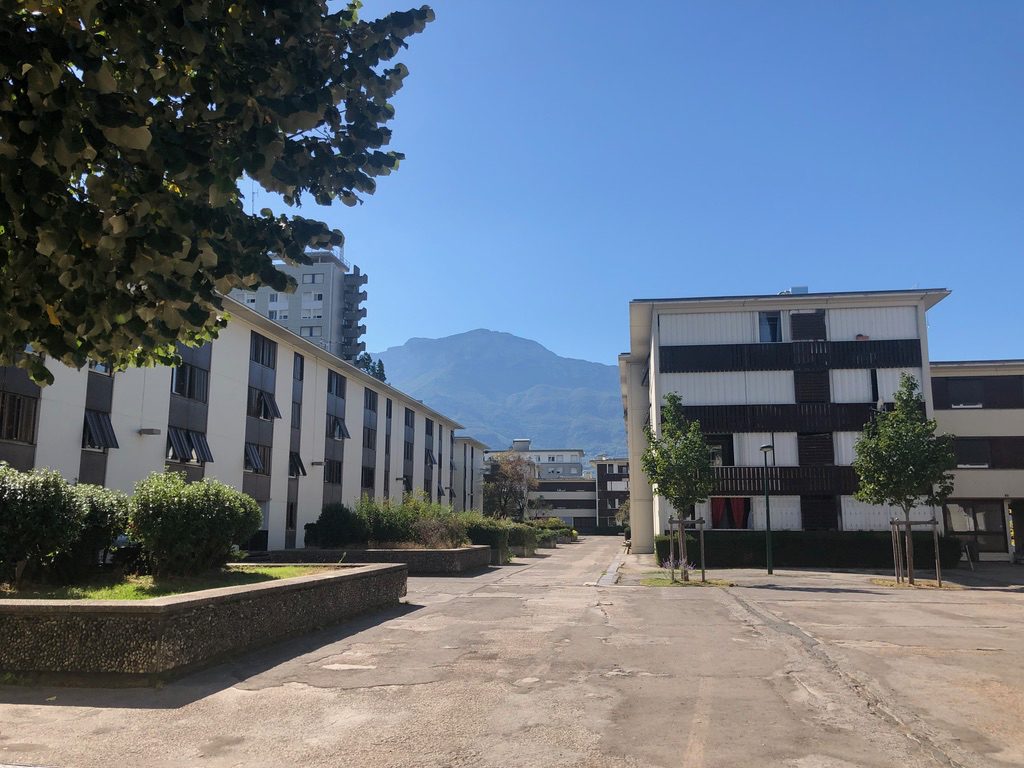
From the beginning, the Olympic Village was designed and built to become an ordinary Grenoble neighborhood. After the Games, the village was divided between the rent-controlled housing (aka Habitation à Loyer Modéré or HLM) and students dormitories.
The Press Center
The Olympic Press Center was located in Malherbe district near the Olympic Village. The press center included a series of residential buildings and related social facilities.
The center was located somewhere close to the Olympic Village. Unfortunately, without the exact address, we failed to find it.
Le Stade de Glace – the Ice Stadium
Nowadays, the stadium is better known as Palais des Sports. It still hosts sporting and cultural events. During Grenoble Olympics, it hosted figure skating competitions and hockey games. Hence, the name – the Ice Stadium. The closing ceremony took place there too.
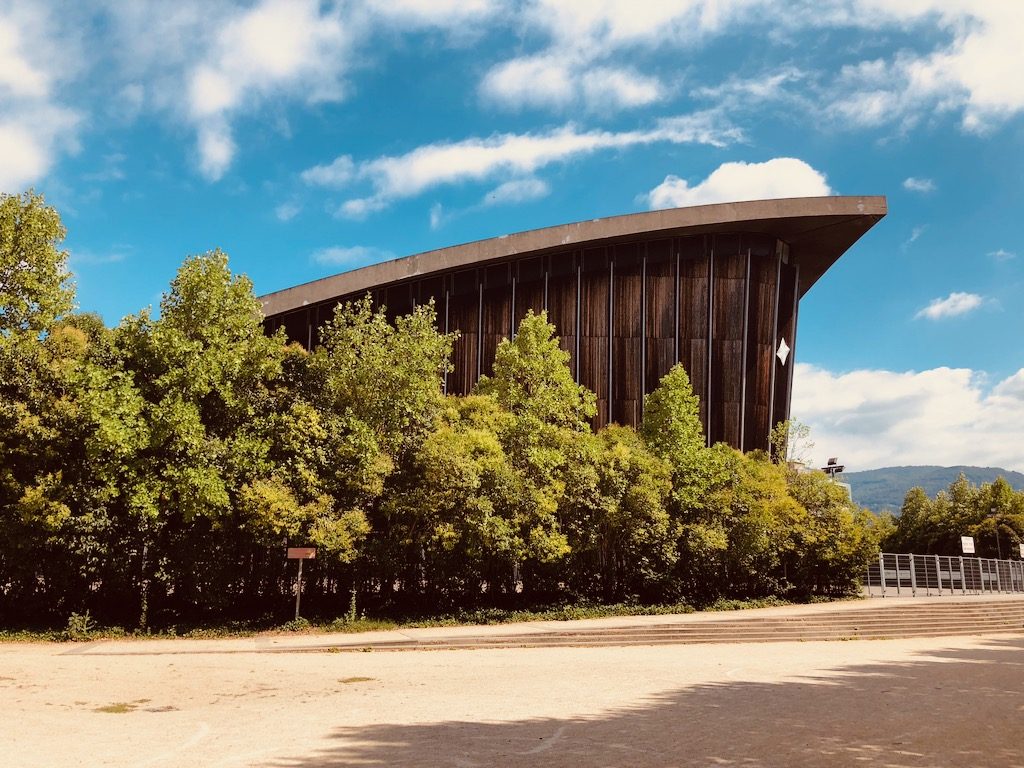
The building is famous for its unusual architecture. The roof consists of two enormous concrete vaults crossed in the middle and supported by only four cantilevered abutments. The stadium can accommodate 12,000 spectators. Its construction began in February 1966 and was completed just a year and a half later in September 1967. The Ice Stadium contributed greatly to the image of the Olympic Winter Games in Grenoble and the prestige of France.
L’Anneau de Vitesse – the Speedskating Ring
L’Anneau de Vitesse (aka the Speed Circuit) was an outdoor speed skating venue located in the Paul Mistral Park in Grenoble.
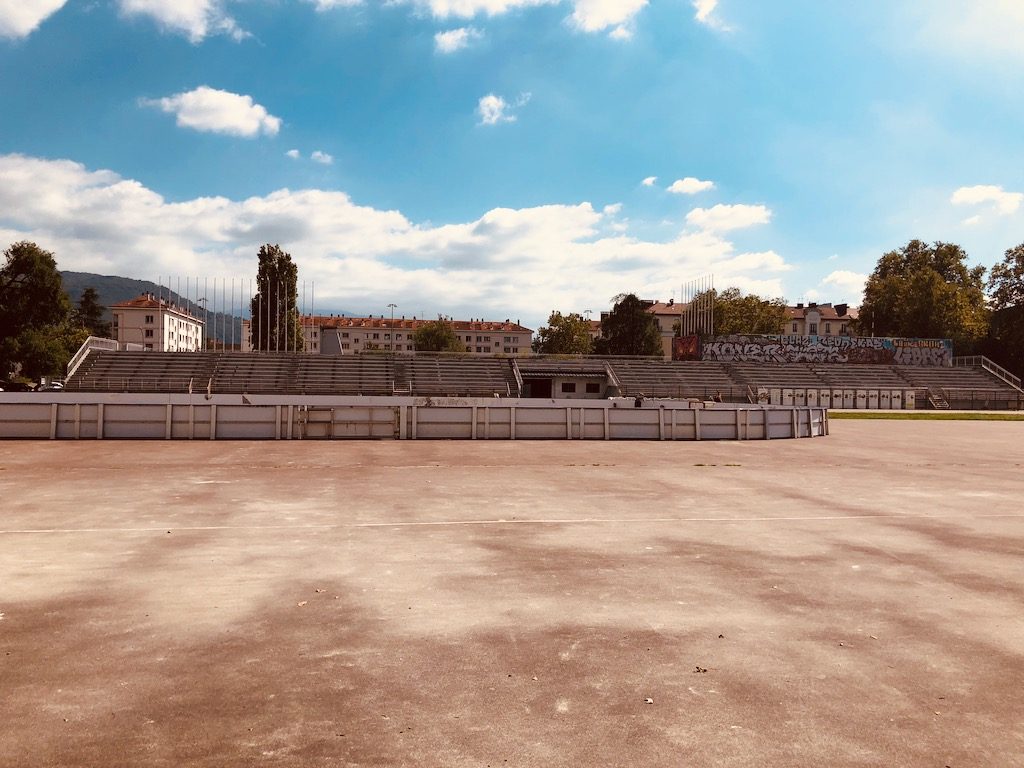
It consisted of a track 400 m long and 14 m wide, two training courses (111m x 30m) and a 2,500-person seating area for spectators. The concrete Ring had to be cooled to stay at -7C. The refrigeration system consisting of 125km of piping was hidden under the bleachers.
Today, L’Anneau de Vitesse is still used by rollerbladers and kids, but not longer iced.
La Patinoire Municipale
Just a few steps away from the Ring, there was another Olympic venue – La Patinoire Municipale (the Municipal Ice Rink) – that hosted some of ice hokey competitions during the Games.
It was opened in 1963 and could seat 2,700 spectators. In 1964 it hosted the 1964 European Figure Skating Championship. Finally, in 2001 it was converted into a gymnasium called Halle Clemenceau.
The Olympic Tram
The A Tram (or the tramway as its called in Grenoble) follows the Olympic footprint.

From the Gare de Grenoble (the Railway station) that was rebuilt for the Winter Olympics the tram goes along the Paul Mistral Park where the Ice Stadium, the Speedskating Ring, the Halle Clemenceau, and the Olympic Cauldron are located.
Moving further south, it stops at the Maison de la culture de Grenoble (aka MC2). The House of Culture of Grenoble was opened in 1968 on the occasion of the Olympic Winter Games. Later, the tram stops at Malherbes, where the Press Center was located and Arlequin that is next to the Olympic Village.
The last stop is at the Alpexpo that served as a transportation hub to the Olympic sports venues outside of the city. Also, within a short walk, there is a site where the temporary Opening Stadium was located with the Olympic Flagpole still standing in the middle of a roundabout.
If you have a few free hours, following the Grenoble Olympic trail is an interesting way to get familiar with the city. Hop-on-hop-off the A tram is the best way to do it.
Here is the map with all the landmarks mentioned above.
Olympic Sites outside Grenoble
In the past decades, Olympic venues stopped been concentrated in a single location. However, half a century ago, it was less common. Thus, Grenoble’s decision to spread out Olympic sites was an innovative.
Indeed, a flat city with lack of snow due to its low altitude couldn’t host some competitions. Luckily, the surrounding mountains were the perfect playground for alpine skiing and other events. Therefore, the X Winter Olympic Games officially adopted a decentralized layout of Olympic sites. The city hosted ice skating competitions (hokey, figure skating and speed skating) and the opening and closing ceremonies. The rest of the events happened in the mountains outside Grenoble.
Here is the list of venues and their current state. Some were repurposed, others came into disrepair and were abandoned. In case you want to visit some of them, you need a car and hiking boots.
Saint-Nizier of the Moucherotte
As mentioned at the beginning of this article, 90m ski jumping competitions were held there. Currently, the site is abandoned.
Autrans
Autrans hosted 70m ski jumping, cross-country, nordic combined and biathlon events. Although it has hosted a minimal number of major international competitions, the site is still active. 70m, 65m, and 20m ski jumping hills are open to athletes for training.
Chamrousse
All alpine skiing events happened there. Nowadays, it is a popular ski resort just 30 km from the city.
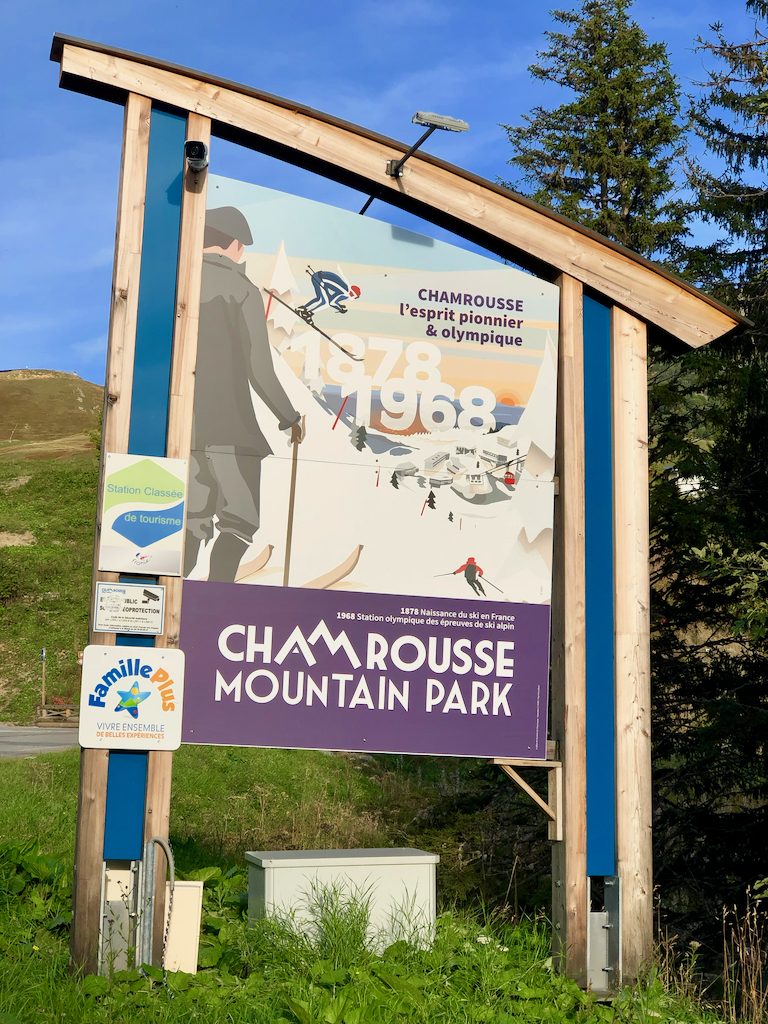
Villard de Lans
Luge events took place in Villard de Lans, the capital of Vercors. Yet, only three races were organized due to the high temperatures. The complex remained active until 1980 before being abandoned. However, the bottom part of the luge track had been renovated recently. It became one of the attractions of the amusement park called Ludi Park.
Alpe d’Huez
Back in the day, Alpe d’Huez was the most modern winter sports resort in the Dauphiné region. Nevertheless, due to its relatively remote location far from Grenoble (61 km in the Oisans massif), only bobsleigh competition was held there. Because of its high altitude (2775 m), it was also a backup site for downhill ski events in case Chamrousse had a problem due to weather conditions.
Ironically, regardless of being located high in the mountains to better preserve ice cover, the concrete bobsleigh track posed a problem. It was constructed facing south where ice kept melting during daytime under the relentless sun. Ultimately, the bobsleigh events were held at night.
After the Olympics, the complex was quickly abandoned. It was demolished in the 90s.
If you liked this article you might also like:
- Mount Jerai Mischief
- Phung Hung Street Art Brings Back Memories of Hanoi
- Paris Walking Tour – Exploring Paris by Getting Lost in It
- What Can You See From The Top Of A Tree?
- Following The Fox Through The Red Gates Into The Shadows
- Side Streets Of Athens
